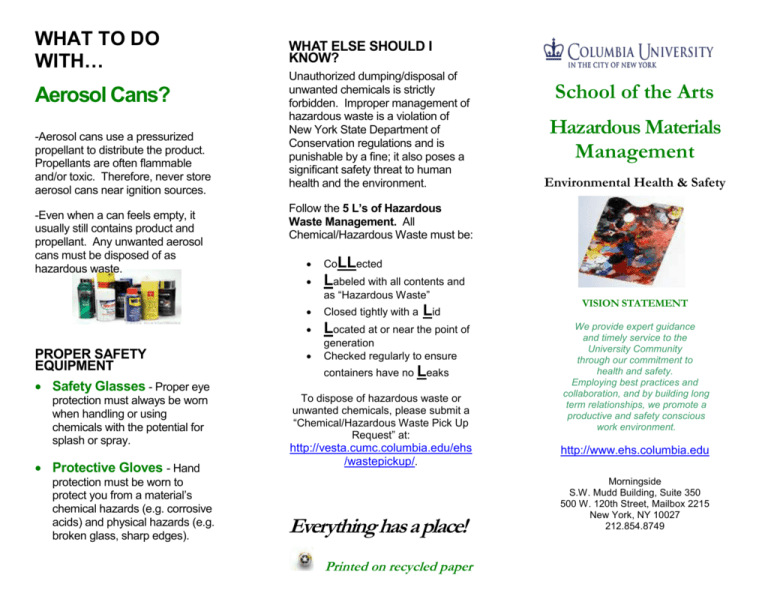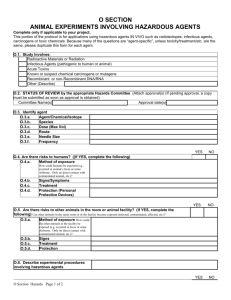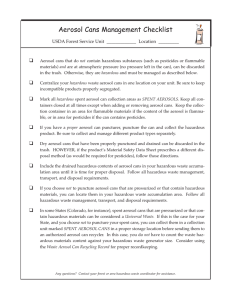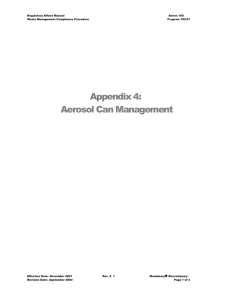Brochure for School of the Arts Hazardous Materials Management
advertisement

WHAT TO DO WITH… Aerosol Cans? -Aerosol cans use a pressurized propellant to distribute the product. Propellants are often flammable and/or toxic. Therefore, never store aerosol cans near ignition sources. -Even when a can feels empty, it usually still contains product and propellant. Any unwanted aerosol cans must be disposed of as hazardous waste. WHAT ELSE SHOULD I KNOW? Unauthorized dumping/disposal of unwanted chemicals is strictly forbidden. Improper management of hazardous waste is a violation of New York State Department of Conservation regulations and is punishable by a fine; it also poses a significant safety threat to human health and the environment. Safety Glasses - Proper eye protection must always be worn when handling or using chemicals with the potential for splash or spray. Protective Gloves - Hand protection must be worn to protect you from a material’s chemical hazards (e.g. corrosive acids) and physical hazards (e.g. broken glass, sharp edges). Hazardous Materials Management Environmental Health & Safety Follow the 5 L’s of Hazardous Waste Management. All Chemical/Hazardous Waste must be: CoLLected Labeled with all contents and as “Hazardous Waste” PROPER SAFETY EQUIPMENT School of the Arts Lid Closed tightly with a Located at or near the point of generation Checked regularly to ensure containers have no Leaks To dispose of hazardous waste or unwanted chemicals, please submit a “Chemical/Hazardous Waste Pick Up Request” at: http://vesta.cumc.columbia.edu/ehs /wastepickup/. Everything has a place! Printed on recycled paper VISION STATEMENT We provide expert guidance and timely service to the University Community through our commitment to health and safety. Employing best practices and collaboration, and by building long term relationships, we promote a productive and safety conscious work environment. http://www.ehs.columbia.edu Morningside S.W. Mudd Building, Suite 350 500 W. 120th Street, Mailbox 2215 New York, NY 10027 212.854.8749 WHAT TO DO WITH… WHAT TO DO WITH… WHAT TO DO WITH… Paint Thinner? Solvent Contaminated Rags? Scrap Film & Spent Fixer? Good, Usable Product: -Keep it in a tightly closed container. All containers must be kept closed when not actively being used. -Must be labeled “Paint Thinner”. Old, Contaminated Product with No Intended Use: -Follow the 5 L’s of Hazardous Waste Management found on the back of this pamphlet. -Carefully transfer the old paint thinner from the one gallon closable can to the 30 gallon metal drum by pouring contents into the attached safety funnel. Make sure the funnel is closed after contents are added. -Rags contaminated with any solvent (e.g. Paint Thinner or California Wash) must be collected. No solvent contaminated rag is to be discarded in the trash. -Rags must be collected for disposal in the red step-on rag cans found inside of the Art/Print Studios. All cans should be lined with plastic bags and kept closed when not actively being used. -Rags must not be left out as to purposely evaporate the materials. - The waste generated in the processing of images/photos contains silver. Silver is a toxic heavy metal regulated by the USEPA, NYDEC, and NYCDEP. All waste from these activities must be collected and/or filtered. -Effluent or spent fixer must be passed through a silver recovery unit to minimize the discharge of silver into municipal waste waters. - Unwanted film from the development process contains silver and must be collected in containers marked “Scrap Film Collection Container”. No film is to be discarded in the trash. To dispose of chemical/hazardous waste, please submit a “Chemical/Hazardous Waste Pick-Up Request” at: http://vesta.cumc.columbia.edu/ehs/wastepickup/







